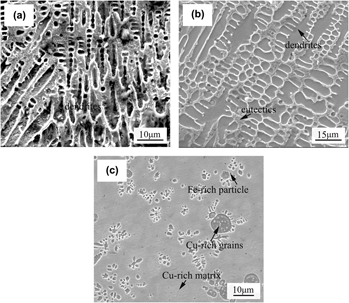Crossref Citations
This article has been cited by the following publications. This list is generated based on data provided by
Crossref.
ZHOU, Sheng-feng
LEI, Jian-bo
XIONG, Zheng
GUO, Jin-bo
GU, Zhen-jie
and
PAN, Hong-bo
2016.
Effect of Fe content on microstructure and mechanical properties of Cu–Fe-based composite coatings by laser induction hybrid rapid cladding.
Transactions of Nonferrous Metals Society of China,
Vol. 26,
Issue. 12,
p.
3196.
Dai, Xiaoqin
Zhou, Shengfeng
Wang, Meifeng
Lei, Jianbo
Xie, Min
Chen, Hanning
Wang, Chunxia
and
Wang, Tao
2017.
Effect of substrate types on the microstructure and properties of Cu65Fe35 composite coatings by laser induction hybrid cladding.
Journal of Alloys and Compounds,
Vol. 722,
Issue. ,
p.
173.
Wang, Kaiming
Chang, Baohua
Chen, Jiongshen
Fu, Hanguang
Lin, Yinghua
and
Lei, Yongping
2017.
Effect of Molybdenum on the Microstructures and Properties of Stainless Steel Coatings by Laser Cladding.
Applied Sciences,
Vol. 7,
Issue. 10,
p.
1065.
Dai, Xiaoqin
Zhou, Shengfeng
Wang, Meifeng
Lei, Jianbo
Wang, Chunxia
and
Wang, Tao
2017.
Microstructure evolution of phase separated Fe-Cu-Cr-C composite coatings by laser induction hybrid cladding.
Surface and Coatings Technology,
Vol. 324,
Issue. ,
p.
518.
Wang, Lin
Bo, Lin
Zuo, Min
and
Zhao, Degang
2018.
Effect of melt superheating treatment on solidification behavior of uniform Al10Bi54Sn36 monotectic alloy.
Journal of Molecular Liquids,
Vol. 272,
Issue. ,
p.
885.
Cao, Chezheng
Liu, Weiqing
Liu, Zhiwei
Xu, Jiaquan
Hwang, Injoo
De Rosa, Igor
and
Li, Xiaochun
2018.
Scalable manufacturing of immiscible Al Bi alloy by self-assembled nanoparticles.
Materials & Design,
Vol. 146,
Issue. ,
p.
163.
Zhou, Shengfeng
Dai, Xiaoqin
Wang, Chunxia
Xie, Min
Yang, Jiaoxi
and
Li, Zhengyang
2018.
Phase separated characteristics and soft magnetic properties of [Cu0.6(FeCrC)0.4]100−xSix immiscible composites by laser induction hybrid cladding.
Journal of Alloys and Compounds,
Vol. 732,
Issue. ,
p.
740.
Bo, Lin
Li, Shanshan
Wang, Lin
Wu, Di
Zuo, Min
and
Zhao, Degang
2018.
Liquid-liquid phase separation and solidification behavior of Al55Bi36Cu9 monotectic alloy with different cooling rates.
Results in Physics,
Vol. 8,
Issue. ,
p.
1086.
Dai, Xiaoqin
Xie, Min
Zhou, Shengfeng
Wang, Chunxia
Yang, Jiaoxi
and
Li, Zhengyang
2018.
Formation and properties of a self-assembled Cu-Fe-Ni-Cr-Si immiscible composite by laser induction hybrid cladding.
Journal of Alloys and Compounds,
Vol. 742,
Issue. ,
p.
910.
Dai, Xiaoqin
Xie, Min
Zhou, Shengfeng
Wang, Chunxia
Gu, Menghao
Yang, Jiaoxi
and
Li, Zhengyang
2018.
Formation mechanism and improved properties of Cu95Fe5 homogeneous immiscible composite coating by the combination of mechanical alloying and laser cladding.
Journal of Alloys and Compounds,
Vol. 740,
Issue. ,
p.
194.
Xie, Min
Zhou, Shengfeng
Jin, Jianbo
Dai, Xiaoqin
and
Chen, Dongchu
2019.
Enhanced corrosion resistance of Kirkendall-effect-induced hollow Fep-reinforced Cu-matrix immiscible alloys by laser powder deposition.
Journal of Alloys and Compounds,
Vol. 779,
Issue. ,
p.
280.
Zhao, Shuzhen
Zhou, Shengfeng
Xie, Min
Dai, Xiaoqin
Chen, Dongchu
and
Zhang, Lai-Chang
2019.
Phase separation and enhanced wear resistance of Cu88Fe12 immiscible coating prepared by laser cladding.
Journal of Materials Research and Technology,
Vol. 8,
Issue. 2,
p.
2001.
Song, Boxue
Yu, Tianbiao
Jiang, Xingyu
Xi, Wenchao
and
Lin, Xiaoli
2020.
Effect of W content on the microstructure and properties of Cu-Fe alloy.
Journal of Materials Research and Technology,
Vol. 9,
Issue. 3,
p.
6464.
Xie, Min
Zhou, Shengfeng
Jin, Jianbo
Zhao, Shuzhen
and
Zhao, Yu
2020.
Microstructure and properties of homogeneous Cu90Fe10 immiscible composites with nanotwins by laser powder deposition: Effect of spot size.
Journal of Alloys and Compounds,
Vol. 821,
Issue. ,
p.
153231.
Xie, Min
Wu, Changyi
Zhou, Shengfeng
Jin, Jianbo
Zhao, Shuzhen
and
Chen, Dongchu
2021.
TiB2- and Fe2P with nanotwins-reinforced Cu-based immiscible composites fabricated by selective laser melting: Formation mechanism and wear behavior.
Journal of Alloys and Compounds,
Vol. 864,
Issue. ,
p.
158716.
Xie, Min
Zhang, Yaozhong
Li, Xi
Li, Fei
and
Zhou, Shengfeng
2022.
Effect of Si Element and Tib2 Nucleating Agent on Microstructure and Magnetic Properties of Cu-Based Immiscible Composites by Laser Melting Deposition.
SSRN Electronic Journal ,
Xie, Min
Zhang, Yaozhong
Li, Xi
Li, Fei
and
Zhou, Shengfeng
2023.
Effect of Si element and TiB2 nucleating agent on microstructure and magnetic properties of Cu-based immiscible composites by laser melting deposition.
Journal of Alloys and Compounds,
Vol. 934,
Issue. ,
p.
167938.
Xie, Min
Li, Fei
Zhou, Shengfeng
Lu, Liangliang
Peng, Fan
Zhang, Longjiang
Zhang, Yaozhong
and
Lu, Yang
2023.
Effect of laser energy density on microstructure and properties Cu–Fe–P immiscible alloys fabricated by laser selective melting: heterogeneous and high strength and magnetic.
Journal of Materials Research and Technology,
Vol. 26,
Issue. ,
p.
2759.
Qiu, Yating
Ren, Pan
Yang, Huan
Guo, Baisong
Shi, Changliang
Lu, Yang
Zhang, Lai-Chang
and
Zhou, Shengfeng
2024.
Laser powder bed fusion of in-situ amorphous oxide dispersion strengthened immiscible Cu-316 L bimetallic composite: Formation mechanism and current-carrying wear behavior.
Tribology International,
Vol. 200,
Issue. ,
p.
110096.
Wen, Chongyu
Qiu, Yatin
Zhang, Zhiguo
Li, Kunmao
Deng, Cheng
Hu, Lianxi
Chen, Dongchu
Lu, Yang
and
Zhou, Shengfeng
2024.
Deformation behavior of heterogeneous lamellar Cu-Fe-P immiscible alloys with enhanced strength and ductility produced by laser powder bed fusion.
Journal of Alloys and Compounds,
Vol. 971,
Issue. ,
p.
172675.


